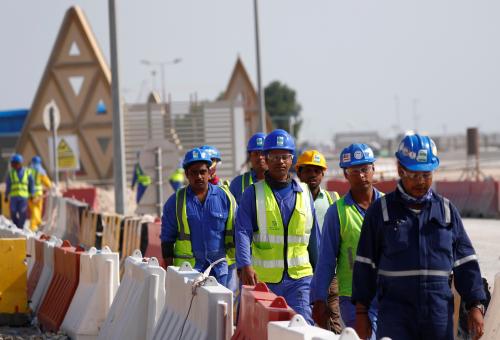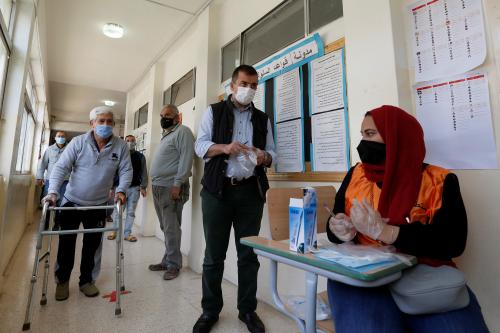Content from the Brookings Doha Center is now archived. In September 2021, after 14 years of impactful partnership, Brookings and the Brookings Doha Center announced that they were ending their affiliation. The Brookings Doha Center is now the Middle East Council on Global Affairs, a separate public policy institution based in Qatar.
Even before the COVID-19 pandemic and collapse in oil prices simultaneously hit the Middle East and North Africa (MENA) region, its countries were grappling with a host of complex challenges, ranging from conflicts in Libya, Syria, and Yemen, to environmental degradation and climate change, to a large demographic bulge placing huge pressure upon governments to provide employment and adequate services for a young and growing population.
Fortunately, through a combination of luck and skill, MENA countries were initially spared the worst of the pandemic. Most reacted quickly with a combination of border closures, economic lockdowns, quarantines and social distancing. These measures were augmented by efforts to ramp up testing and improve access to medical supplies, such as masks, ventilators, and personal protective equipment (PPE). Other measures sought to ease the pandemic’s economic burden and look after vulnerable segments of society, although such steps often faced significant fiscal constraints and were less extensive than those pursued by countries in the Organization for Economic Cooperation and Development (OECD). In some respects, the early phases of the pandemic catered to the region’s comparative advantage, in that implementation of the initial containment measures fell largely upon the army and the police—long among the most powerful and well-resourced institutions within the region. These lockdown measures were, with noticeable exceptions, generally capable of slowing the spread of the virus and keeping early infection and fatality numbers low.
By early July, rates of infection and fatalities per capita were well below those found in hard-hit regions in Europe, South Asia, the United States and Latin America. At a time when the United Kingdom and Italy were approaching 600 fatalities per million population and the United States stood at 386, Saudi Arabia had 47 COVID-19 fatalities per million; the UAE had 32; and Morocco had just over 6. Even more exemplary, Tunisia had only 4.2 fatalities per million and Jordan led the region at only .9—rates that compared favorably at the time with global best performers such as Australia (4.1), New Zealand (4.6), and South Korea (5.5).
Unfortunately, it was not to last. Countries such as Jordan and Tunisia faced pressure to open up their economies, and they rolled back many preventive measures in May and June. After a lag over the summer, the number of coronavirus infections began increasing rapidly in September. Other countries, such as Morocco, enforced social distancing measures unevenly; they also experienced a rapid rise in cases. It was always clear that, should the virus break containment and spread unchecked in the region through crowded slums, underserved rural hinterlands, refugee camps, or countries in political turmoil and conflict, the results could be dire.
As the pandemic drags on, the MENA region is now starting to see patterns of mortality and morbidity that align more closely with those of other regions. As of early December 2020, the MENA region as a whole still remained below global rates of fatalities per million population but was making up distance. And the order of countries within the region had changed. The UAE is now the region’s best performer, with a fatality rate per million of 58.2, followed by Qatar at 82.6. Saudi Arabia has 169.7 fatalities per million, Jordan has 274.6, and Tunisia has 275.8.
Countries in or emerging from conflict are particularly at risk. After initially avoiding the worst of the virus, Libya witnessed a rapid uptick in July and August, leading to fears that COVID-19 would have a devastating impact due to the country’s chaotic governance environment and the dilapidated nature of its healthcare infrastructure. Countries such as Syria appear to be suffering badly but are actively involved in suppressing data on the severity of the pandemic. One recent epidemiological analysis of Damascus concluded that official statistics are reporting only around 1.25 percent of actual fatalities. As long as such hot spots remain, it will be difficult to contain the spread of the virus in MENA countries.
Against this discouraging backdrop, there are modest reasons for hope. Fatality rates among those who contracted the disease have dropped throughout the region (with the notable exception of Egypt, where rates remain frustratingly high). This is part of a global trend that may reflect improvements in how the disease is being treated. And some countries, such as Qatar, have been able to ramp up testing to impressive levels, holding the promise that a more targeted approach involving robust testing, contract tracing, and focused hot-spot interventions could be feasible, at least in a few countries. The pandemic could also give impetus to some important regional initiatives, such as a MENA Center for Disease Control, which could help support the dissemination of COVID-19 vaccines throughout the region, as well as reduce the future risk of chronic and infectious diseases.
While the development of a vaccine or vaccines for COVID-19 is certainly welcome, it is unlikely to provide immediate relief. A number of MENA countries have signed commitment agreements to the World Health Organization’s COVID-19 vaccine Global Access Facility (COVAX), a global initiative to work with vaccine manufacturers to provide countries with equitable access to safe and effective vaccines. Yet the efficacy of the COVAX agreement remains to be seen, as many signatories (such as Britain and the European Union) and non-signatories (such as the United States) are continuing to pursue their own bilateral deals with manufacturers that will claim a large share of initial vaccine production. Beyond gaining access to vaccines, it will be a challenge disseminating them to many parts of the MENA region, including to countries in conflict or rural areas lacking adequate cryogenic storage facilities.
There are signs that the pandemic could usefully nudge along some important reforms in governance and public management. Virtually all countries have established central coordinating committees to address the virus, which have played an important role in improving the quality of policy harmonization and operational integration in a region known for rigid stove-piped ministries and weak intergovernmental coordination. It will provide further impetus to the transition to e-governance and m-governance—one of the few areas in which the MENA region fares well on global governance indices. The fiscal dislocations will provide additional incentive to reduce costs and improve the efficiency of government operations. And the need to support vulnerable members of the population could provide further support for reworking the prevailing social contract within the Gulf Cooperation Council (GCC), moving away from de facto public sector job guarantees toward a minimum basic income.
Yet for the region as a whole, the pain caused by the pandemic will be immediate and tangible, whereas any potential downstream gains will be delayed and diffuse. The disease will likely impact the MENA region directly for several years to come and indirectly for even longer. Its ravages can be mitigated and reduced, but not avoided. However, through the right combination of foresight and policy and institutional reforms, MENA countries can emerge both better able to prevent such disasters in the future and with a set of more agile and responsive institutions that will help them to tackle other pernicious development challenges.
The Brookings Institution is committed to quality, independence, and impact.
We are supported by a diverse array of funders. In line with our values and policies, each Brookings publication represents the sole views of its author(s).





Commentary
Op-edThe Middle East and North Africa and COVID-19: Gearing up for the long haul
December 13, 2020